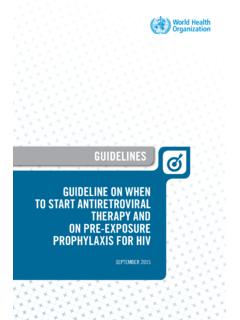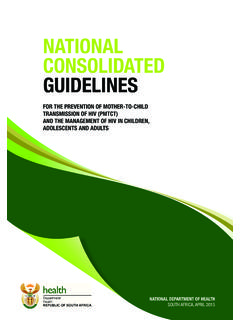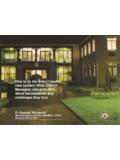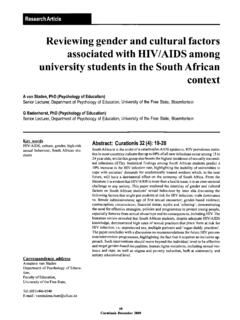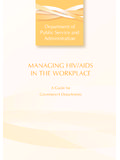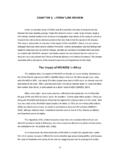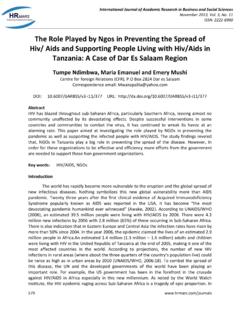Transcription of HIV and/or AIDS awareness among adolescents in a …
1 AccessSouthern African Journal of HIV Medicine ISSN: (Online) 2078-6751, (Print) 1608-9693 Page 1 of 7 Original ResearchRead online:Scan this QR code with your smart phone or mobile device to read :Simon Taukeni1 Ronel Ferreira2 Affiliations:1 HIV and aids Unit, University of Fort Hare, South Africa2 Department of Educational Psychology, University of Pretoria, South AfricaCorresponding author:Simon Taukeni, 16 Sept. 2015 Accepted: 22 Mar. 2016 Published: 09 June 2016 How to cite this article:Taukeni S, Ferreira R. HIV and/or aids awareness among adolescents in a South African at-risk rural community. S Afr J HIV Med. 2016;17(1), a418. : 2016. The Authors. Licensee: AOSIS. This work is licensed under the Creative Commons Attribution estimates that about 35 million people were living with HIV and/or aids in 2013, of which were situated in sub-Saharan Africa. In South Africa alone, million children had been orphaned by aids at the time and around million people were living with HIV and/or Worldwide, many of those affected are women and narrowing the focus to adolescent children and young adults, worldwide figures indicated million HIV-positive youth within the age range 15 In many parts of the globe, young people, particularly adolescents , are at great risk of contracting the virus through sexual activity as well as sexual exploitation and Durojaiye5 as well as UNAIDS6 indicate that, worldwide, 45% of people contracting HIV and/or aids are youth aged 15 24 years.
2 This is supported by Ebeniro7 and other scholars who found that adolescents aged 15 24 years constitute the largest population of HIV-infected subjects. Similarly, AVERT2 indicates a high HIV prevalence in the age group 15 : The devastating effects of HIV and/or aids are widely documented. Despite ongoing efforts to address the challenges associated with the pandemic, the impact on children orphaned because of the disease, as well as on adolescents , remains problematic. More specifically, orphaned adolescents living in poverty are particularly vulnerable and are often exposed to, for example, emotional and physical abuse and transactional sexual exploitation. Against this background, the importance of informed awareness among adolescents is continually emphasised, yet the outcomes of awareness campaigns require ongoing : The main objective of this study was to explore HIV and/or aids awareness among adolescents living in a rural community in South Africa, in the Chris Hani District of the Eastern Cape Province.
3 Sixteen adolescents (aged 12 24) who had lost one or both of their parents because of HIV and/or aids -related reasons were purposefully selected to participate in the : For this qualitative investigation, we implemented a descriptive case study design. Semi-structured individual interviews, observation and field notes were used to collect and document data, and inductive thematic analysis was completed using the software programme : The three themes that were identified relate to HIV and/or aids awareness , disclosure of parents HIV and/or aids status and experiences of adolescents surrounding the death of their parents. adolescents of the community viewed HIV and/or aids as an infectious disease that can lead to death; however, this can be prevented by avoiding at-risk sexual behaviour. Schools and family members were the main sources of information regarding HIV and/or aids to the participants.
4 Even though parents tended not to disclose their HIV and/or aids status, adolescents became aware of their parents status when reading about this on their parents medical report cards or when being told about the status by others following the death of their parents. For adolescents , their parents deaths were associated with the parents being chronically ill or showing visible signs of deterioration such as weight : The study concludes that even though current campaigns and informative interventions have seemingly succeeded in ensuring HIV and/or aids awareness among adolescents also those in remote areas continued educational campaigns are important. Such initiatives may prove to be beneficial by focusing on ways that parents can discuss HIV and/or aids -related issues with their children and disclose an HIV-positive and/or aids awareness among adolescents in a South African at-risk rural communityRead online:Scan this QR code with your smart phone or mobile device to read 2 of 7 Original AccessAdolescents find themselves in a developmental phase where they search for an identity and are often negatively influenced by their peers.
5 Adding poverty and parental sickness, or orphanhood, to the challenges already experienced during adolescence will result in high levels of vulnerability. More specifically, orphaned adolescents living in poverty are particularly at risk of emotional and physical abuse and transactional sexual African context as backdrop to the studyAccording to Statistics South Africa,9 this country accounts for the highest number of people living with HIV and/or aids in the world, currently estimated at of the total population. Sinelela et confirm this by very recently stating that:South Africa is home to the largest concentration of people living with HIV anywhere in the world; of all the HIV-positive people in the world, nearly one fifth live in South Africa. ( )In terms of the rise in numbers, it is rather concerning to note the increase from million people living with HIV and/or aids in South Africa in 2002 to million in HIV and/or aids pandemic has caused unprecedented suffering and social disruption for children and communities throughout sub-Saharan Even though all children are vulnerable and at risk of contracting HIV, it was, for example, reported in a study by Mpanju-Shumbusho12 that, in sub-Saharan Africa, teenage girls HIV infection rate is five times higher than the rate of infection among teenage boys.
6 Against the background of the challenge of HIV and/or aids encountered by adolescents , it seems vitally important that their awareness of the risks associated with sexual behaviour, and the importance of applying this knowledge to real-life experience, is made (ages 10 19) find themselves in a phase of physical growth and development accompanied by sexual maturation, which often lead to intimate Additionally, adolescents orphaned by HIV and/or aids or living with sick parents as a result of the disease, in poor conditions, are specifically vulnerable to transactional sexual Even though the 1998 South African Demographic and Health Survey indicated that awareness and knowledge about HIV and/or aids are high among adolescents in South Africa, this has seemingly not translated into substantial behaviour change among , South Africa has a range of relevant policies and interventions geared towards fighting the HIV and/or aids scourge15 in place.
7 Examples of these include the National Strategic Plan on HIV and/or aids and STD 2000 2005, the National Strategic Plan on HIV and aids and STI 2007 2011, and the current policy of National Strategic Plan on HIV, STIs and TB 2012 2016. These policies are an indication that the South African government and its partners have the intention to address the HIV and/or aids pandemic, despite attempted actions not yet showing results in terms of changed behaviour and a reduction in HIV and/or aids prevalence among this age challenges and the current state of affairs in South Africa add to the vulnerability of adolescent children. Currently, of all South African citizens are considered to live in poverty,16 and the unemployment level is estimated to be Poverty and high levels of unemployment have resulted in people at the ground level pursuing all possible avenues to survive, even if this may place the well-being of the family and children at risk.
8 It is a common phenomenon that parents seek employment away from home, resulting in a situation where many children reside with relatives or even friends. Such living arrangements and the lack of parental involvement intensify the vulnerability of children, more so during the developmental phase of adolescents , when children are in need of the involvement and support of caring addition to the developmental phase and prominent effect of peer pressure adding to the vulnerability of adolescents not cared for by their parents, social challenges such as abuse, violence and promiscuity in poor communities in South Africa add to the challenges these children face. Furthermore, the high prevalence of HIV and/or aids and related deaths in South Africa have resulted in high numbers of orphaned children million in 2009 and estimated to increase to almost million children in These children need to be cared for, or in some cases where parents live with HIV and/or aids , children are expected to take over the role of provision from their parents, in order to support sick parents and siblings to The death of parents and migration to other regions in pursuing careers, have also resulted in the phenomenon of child-headed households in South Africa.
9 This further intensifies the population of vulnerable and at-risk children (often adolescents ) in South this background, the present study explored the awareness of HIV and/or aids among adolescents whose parents had died of HIV and/or aids , in an at-risk rural community in the Chris Hani District in the Eastern Cape of South Africa. The rationale for undertaking the study rested on scientific evidence indicating that knowledge about HIV and/or aids is essential for adolescents to be able to make rational decisions regarding sexual behaviour and protecting themselves against HIV Because there is no cure for aids , prevention remains the only sure way for combating the adolescents are often victims of the pandemic, because of reasons such as limited awareness of HIV and/or aids or inadequate access to HIV prevention and treatment The study could thus add new insights in terms of the effect of such community-based initiatives and preventative campaigns among adolescents in at-risk rural population and sampleA qualitative approach was followed and a descriptive case study design employed to conduct the study.
10 The target Page 3 of 7 Original Accesspopulation comprised all adolescents whose parents had died of HIV and/or aids -related illnesses, who reside in a rural community in the Eastern Cape Province of South Africa. This village represents at-risk rural communities in South Africa and is characterised by high levels of poverty, HIV and/or aids prevalence and vulnerable children some because of being orphaned and some as a result of parents not residing with their children. A sample of 16 children (10 boys and 6 girls), aged 11 24 years, were included in the of participantsPurposive sampling was used to select the participants. Community members played a crucial role in the initial identification of adolescents who could potentially provide rich information on the HIV and/or aids awareness among youth in the specific community.



